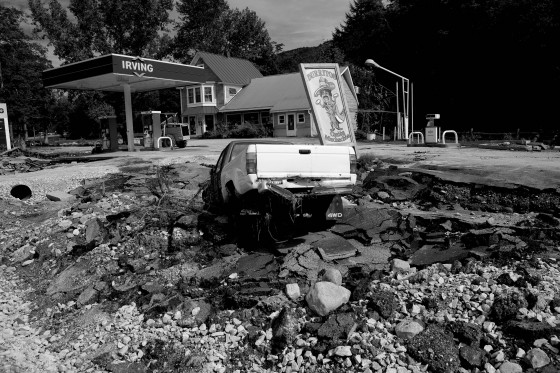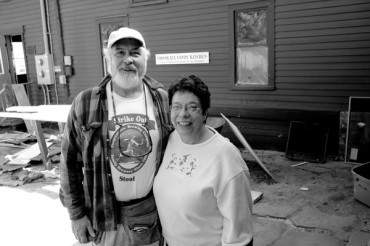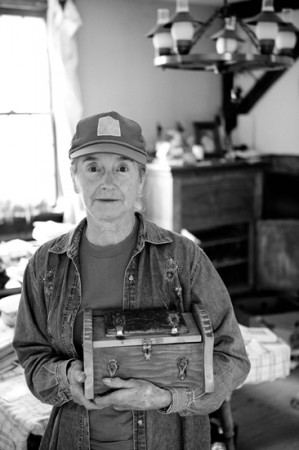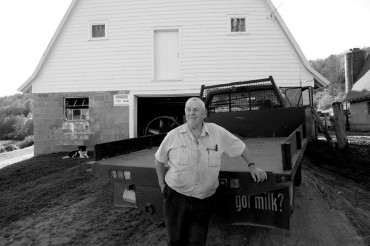Voices From the Flood
In the year since Tropical Storm Irene barreled through New England, Vermont continues to recover. The storm claimed lives and homes. Businesses, too. And in certain sections of the state, entire towns were cut off for days from assistance. But Vermont and Vermonters are resilient. Communities quickly banded together and today the state is back […]

Susan Haughwout | The Town Clerk

Photo Credit : Ian Aldrich
George & Jan Knowles | The Volunteers
 One of the more heartwarming stories to emerge from the days and weeks that followed Tropical Storm Irene was the number of people who volunteered their time to help communities regain their footing. Some came from out of state, many others from neighboring towns.
George and Jan Knowles were part of the contingent. The retired South Newfane residents spent their first few days helping out neighbors before making their way to nearby Wilmington, one of the state’s hardest hit towns. The bulk of their hours were spent helping out Al and Suzanne Wurzberger, two longtime downtown business owners, who operate the 1836 Country Store as well as Norton House, a popular quilt shop. “They had a sign out asking for volunteers,” said George. “So we popped in and just asked, ‘What can we do?’
To hear more of their story, click on the link below.
[haiku url=”http://blogs.yankeemagazine.com/behind-scenes-magazine/files/2011/12/Knowles-Final.mp3″ title=”Title of audio file”]
One of the more heartwarming stories to emerge from the days and weeks that followed Tropical Storm Irene was the number of people who volunteered their time to help communities regain their footing. Some came from out of state, many others from neighboring towns.
George and Jan Knowles were part of the contingent. The retired South Newfane residents spent their first few days helping out neighbors before making their way to nearby Wilmington, one of the state’s hardest hit towns. The bulk of their hours were spent helping out Al and Suzanne Wurzberger, two longtime downtown business owners, who operate the 1836 Country Store as well as Norton House, a popular quilt shop. “They had a sign out asking for volunteers,” said George. “So we popped in and just asked, ‘What can we do?’
To hear more of their story, click on the link below.
[haiku url=”http://blogs.yankeemagazine.com/behind-scenes-magazine/files/2011/12/Knowles-Final.mp3″ title=”Title of audio file”]
Florence Craft | The Homeowner
 “I didn’t know it would be this bad,” Florence Craft says, stepping around the piles of personal items that consume much of her living room floor. Six weeks had passed since Irene had hit, and the 76-year-old widow had hardly scratched the surface on the work to get her life back. She was wearing clothes given to her by strangers, living with a friend in nearby Wardsboro, and wondering how or when she’d be able to move back into the only home she’s known for the last 55 years.
In November 1956 she and her husband, George, were just two weeks married at the time, when they moved into this 19th century Cape and started fixing the old place up. The work was considerable. For nearly 30 years the house, which sits just off Route 100 in Wilmington had largely sat untouched after an earlier natural disaster, the flood of 1927, had nearly taken it down. When the Crafts scooped it up, the property had no electricity, no running water, just a lot of potential. Together they refinished rooms, put on an addition, and made it the kind of cozy family home that would welcome three children, and later a growing lineup of grandchildren and great-grandchildren. Even after George’s passing in June 2004, Florence never entertained the thought of moving elsewhere.
Then came Tropical Storm Irene. After vacating her house the morning of the storm, Craft returned to a home that had withstood 35 inches of water. She didn’t have flood insurance and if she does move back in, it won’t be until spring, at the earliest. In mid-October, when I visited, Craft’s days were consumed with cleaning up a lifetime of memories.
“It’s quite a project,” she said softly. “I don’t know if it’s worth it.”
To hear more about Craft and what she’s contending with, click on the link below.
[haiku url=”http://blogs.yankeemagazine.com/behind-scenes-magazine/files/2011/09/Florence-Craft_1.mp3″ title=”Title of audio file”]
“I didn’t know it would be this bad,” Florence Craft says, stepping around the piles of personal items that consume much of her living room floor. Six weeks had passed since Irene had hit, and the 76-year-old widow had hardly scratched the surface on the work to get her life back. She was wearing clothes given to her by strangers, living with a friend in nearby Wardsboro, and wondering how or when she’d be able to move back into the only home she’s known for the last 55 years.
In November 1956 she and her husband, George, were just two weeks married at the time, when they moved into this 19th century Cape and started fixing the old place up. The work was considerable. For nearly 30 years the house, which sits just off Route 100 in Wilmington had largely sat untouched after an earlier natural disaster, the flood of 1927, had nearly taken it down. When the Crafts scooped it up, the property had no electricity, no running water, just a lot of potential. Together they refinished rooms, put on an addition, and made it the kind of cozy family home that would welcome three children, and later a growing lineup of grandchildren and great-grandchildren. Even after George’s passing in June 2004, Florence never entertained the thought of moving elsewhere.
Then came Tropical Storm Irene. After vacating her house the morning of the storm, Craft returned to a home that had withstood 35 inches of water. She didn’t have flood insurance and if she does move back in, it won’t be until spring, at the earliest. In mid-October, when I visited, Craft’s days were consumed with cleaning up a lifetime of memories.
“It’s quite a project,” she said softly. “I don’t know if it’s worth it.”
To hear more about Craft and what she’s contending with, click on the link below.
[haiku url=”http://blogs.yankeemagazine.com/behind-scenes-magazine/files/2011/09/Florence-Craft_1.mp3″ title=”Title of audio file”]
Henry Wheeler | The Farmer
 Henry Wheeler was only five when the Hurricane of ’38 rolled through New England and flooded communities, including his own hometown of Wilmington, Vermont. But the memories from that storm still resonate with him. The Wheeler farm–a dairy and maple sugaring operation set on 350 acres along Route 100–managed to survive ’38, thanks in part to a community of farmers who pitched in and helped Henry’s father get his farm back up and running. It was much the same following Tropical Storm Irene, with farmers again banding together to help the Wheelers repair roads and fences, and help ensure that Wheeler farm, now largely run by Henry’s two sons, Rob and John, could quickly overcome the damages and get back to the real work at hand.
“It was pretty awesome,” says Wheeler.
[haiku url=”http://blogs.yankeemagazine.com/behind-scenes-magazine/files/2011/10/Output-1-2.mp3″ title=”Title of audio file”]
Henry Wheeler was only five when the Hurricane of ’38 rolled through New England and flooded communities, including his own hometown of Wilmington, Vermont. But the memories from that storm still resonate with him. The Wheeler farm–a dairy and maple sugaring operation set on 350 acres along Route 100–managed to survive ’38, thanks in part to a community of farmers who pitched in and helped Henry’s father get his farm back up and running. It was much the same following Tropical Storm Irene, with farmers again banding together to help the Wheelers repair roads and fences, and help ensure that Wheeler farm, now largely run by Henry’s two sons, Rob and John, could quickly overcome the damages and get back to the real work at hand.
“It was pretty awesome,” says Wheeler.
[haiku url=”http://blogs.yankeemagazine.com/behind-scenes-magazine/files/2011/10/Output-1-2.mp3″ title=”Title of audio file”]
Richard Champine | The Survivor
 I first met Richard Champine two weeks after Irene had rolled through. Not surprisingly he was still figuring out how to pick up the pieces of his life. His home of 14 years, a small apartment above a gas station in Killington at the junction of routes 4 and 100, was destroyed by the fast moving river waters that flooded the area. So severe was the damage that Champine and his son, Richard Jr., abandoned the home at the height of the storm and spent the next 21 hours atop a car that was parked in front of the building. Two weeks after Irene, Richard was living temporarily at the neighboring Cedarbrook Motor Inn, where he works as a handyman. As he waited for an insurance adjuster to assess the property, he told me about his life during the storm and his escape. To hear Richard tell his story, click on the link below.
[haiku url=”http://blogs.yankeemagazine.com/behind-scenes-magazine/files/2011/09/Richard-Champine.mp3″ title=”Title of audio file”]
I first met Richard Champine two weeks after Irene had rolled through. Not surprisingly he was still figuring out how to pick up the pieces of his life. His home of 14 years, a small apartment above a gas station in Killington at the junction of routes 4 and 100, was destroyed by the fast moving river waters that flooded the area. So severe was the damage that Champine and his son, Richard Jr., abandoned the home at the height of the storm and spent the next 21 hours atop a car that was parked in front of the building. Two weeks after Irene, Richard was living temporarily at the neighboring Cedarbrook Motor Inn, where he works as a handyman. As he waited for an insurance adjuster to assess the property, he told me about his life during the storm and his escape. To hear Richard tell his story, click on the link below.
[haiku url=”http://blogs.yankeemagazine.com/behind-scenes-magazine/files/2011/09/Richard-Champine.mp3″ title=”Title of audio file”]
Charlie Shackleton | The Furniture Maker
When Irene hit, it hit the business hard, flooding Thomas’ pottery studio, and filling the mill’s basement with more than eight-feet of water before receding and leaving a wasteland of mud and silt. While the building’s upstairs shop rooms and store were saved, much of Shackleton’s lumber was ruined, as were a number of machines. Cost of the damage clocked in at well over six figures, with only a portion of it covered by flood insurance. Still, when we visited the Irish-born Shackleton in mid September, he seemed optimistic about his business’ ability to get back on its feet. Which it has. By late September, ShackletonThomas had reopened for business.Ian Aldrich
Ian Aldrich is the Senior Features Editor at Yankee magazine, where he has worked for more for nearly two decades. As the magazine’s staff feature writer, he writes stories that delve deep into issues facing communities throughout New England. In 2019 he received gold in the reporting category at the annual City-Regional Magazine conference for his story on New England’s opioid crisis. Ian’s work has been recognized by both the Best American Sports and Best American Travel Writing anthologies. He lives with his family in Dublin, New Hampshire.
More by Ian Aldrich

